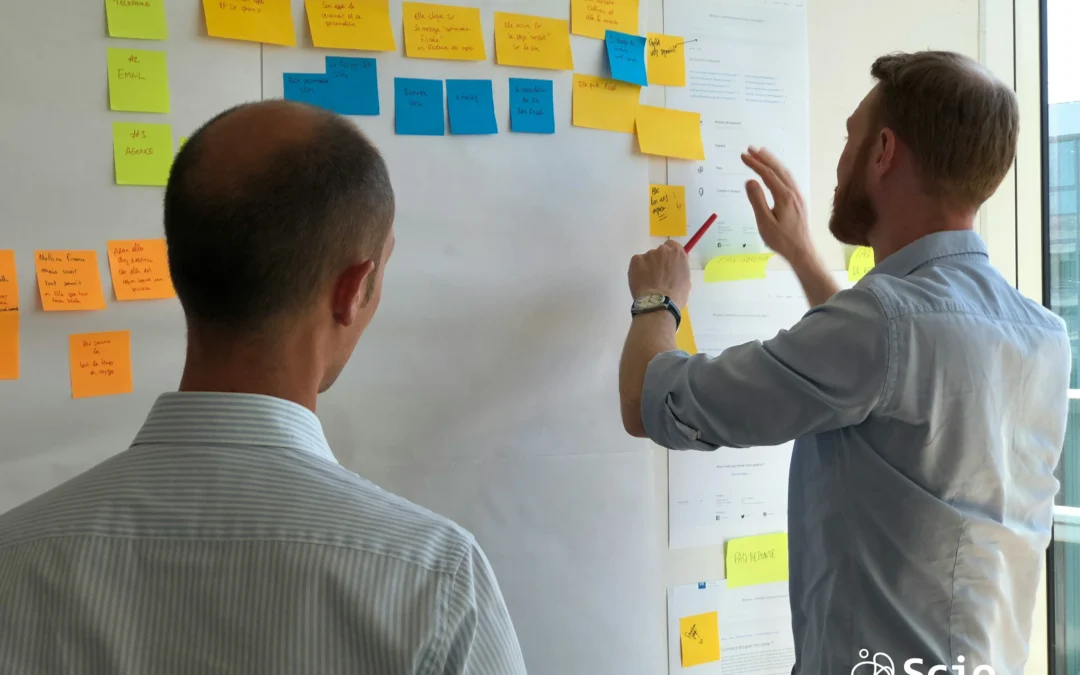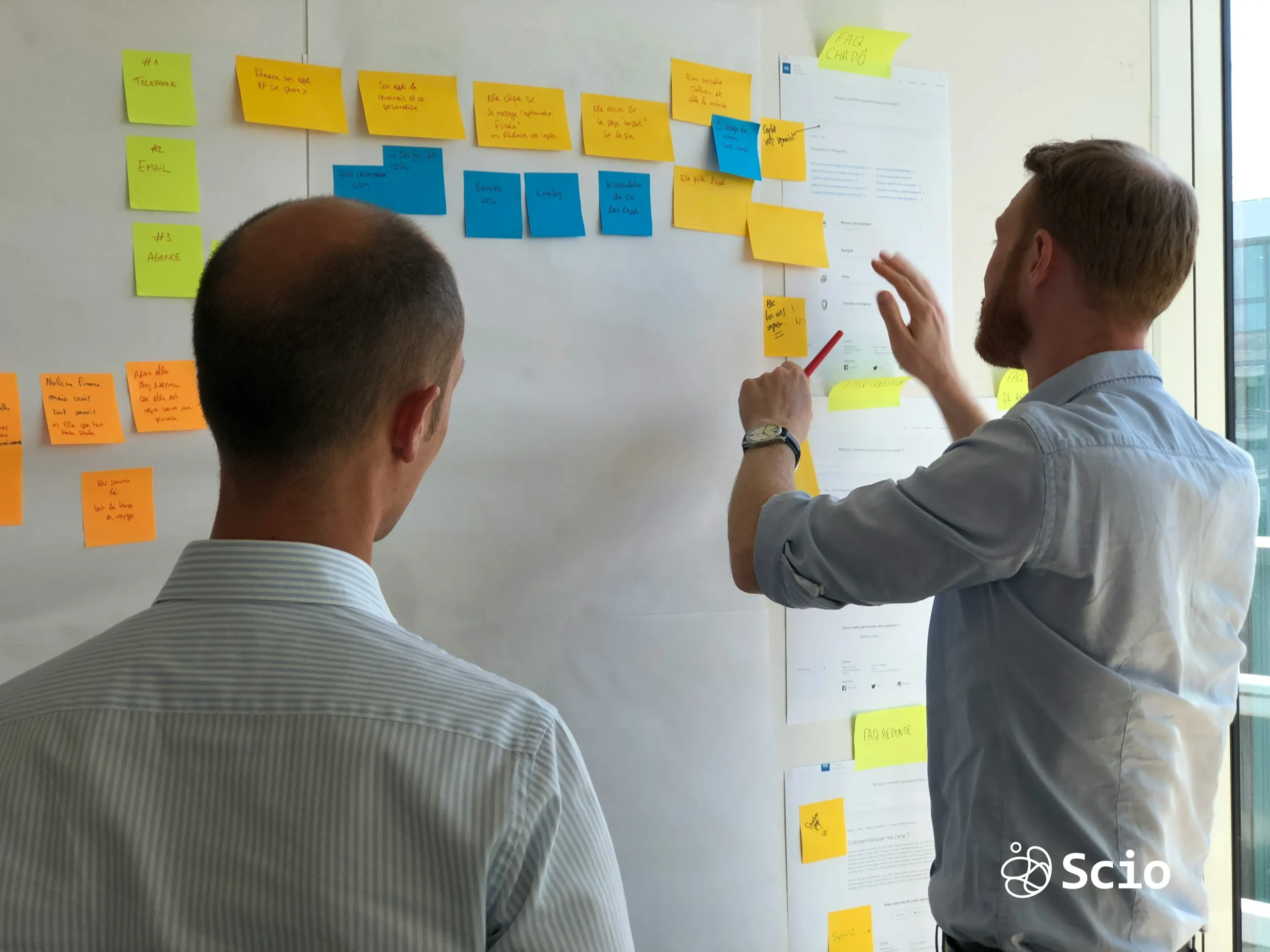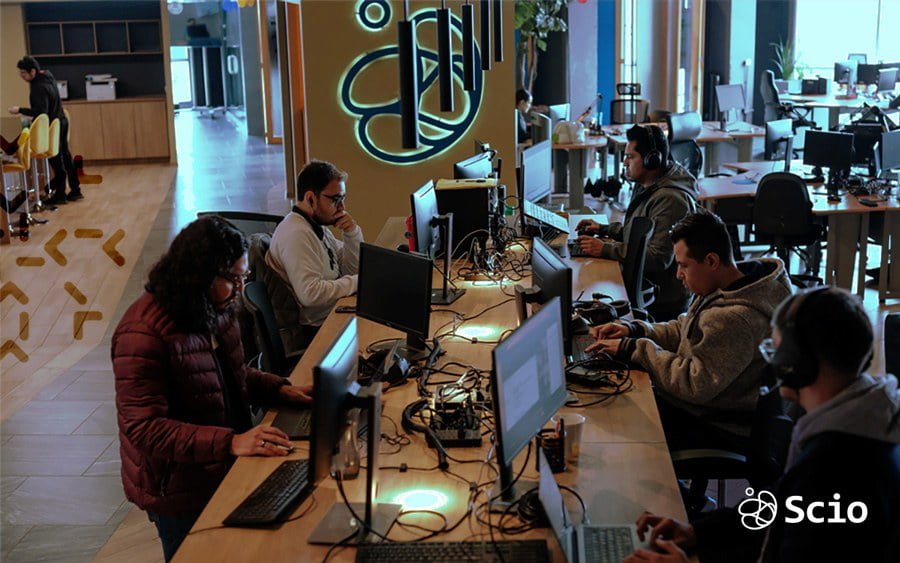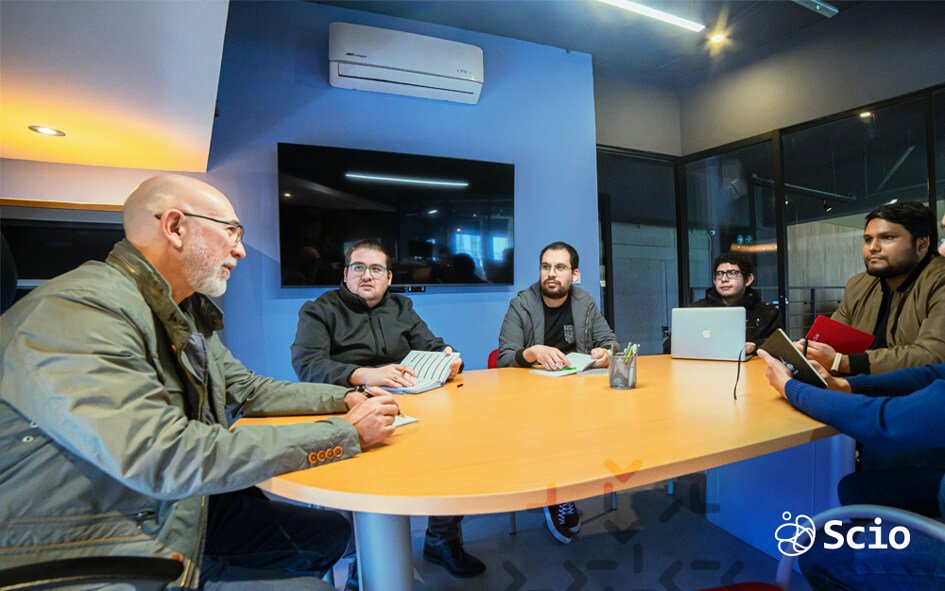
Strategic Nearshoring for Tech Companies: Luis Aburto’s Vision for Outcomes-Driven Partnerships
Written by: Luis Aburto –

The Software Development leaders of tech companies are constantly searching for ways to scale their engineering teams, hit aggressive product development milestones, and deliver innovation more efficiently. While outsourcing has traditionally been a common solution, many tech companies are finding that simple transactional relationships with outsourcing providers fall short of delivering the long-term results they need.
For Luis Aburto, CEO of Scio, the answer lies in strategic nearshoring and a shift toward outcomes-driven partnerships. Scio, a software development company based in Mexico, leverages nearshoring to help North American tech companies scale their teams with real-time collaboration, cultural alignment, and cost efficiency.
In this interview, John Suvanto, a renowned Vistage Chair in Dallas, TX and Luis’ Executive Coach, explores how Scio’s Outcomes-Driven Engagement Model and its focus on business and cultural alignment are reshaping the way tech companies approach partnerships. Together, they dive into how Scio is helping companies achieve measurable business outcomes, improve engineering productivity, and meet product roadmap goals more effectively through long-term collaboration.
Interview
John Suvanto (Chair, Vistage Dallas):
Luis, it’s great to sit down with you again. As someone who’s watched your journey for several years, I’ve been particularly impressed with how Scio has developed its Outcomes-Driven Engagement Model. For our readers, could you start by introducing Scio and sharing a bit about the philosophy behind this model?
Luis Aburto (CEO, Scio):
Thanks, John. I’m happy to be here and to talk about our approach. Scio is a software development company based in Austin, TX that leverages talent in Mexico and other countries in Latin America to deliver custom technology solutions to North American clients. So, one of the key aspects of our business model is nearshoring—we’re in the same or similar time zones as our clients, which allows for real-time collaboration, faster decision-making, and better cultural alignment, all while keeping costs competitive.
As we’ve grown, we recognized that the traditional transactional outsourcing model wasn’t enough to truly support our clients’ needs—especially tech or tech-enabled companies that are scaling rapidly or trying to hit aggressive product development goals. That’s where our Outcomes-Driven Engagement Model comes in. Instead of just delivering a service and moving on, we partner with our clients to align our work with their business outcomes, focusing on achieving real, measurable results.
John Suvanto:
I think that’s an important distinction. Many companies that work with external development teams are used to a time and materials or a deliverables-based approach, but you’ve shifted the conversation to outcomes, which requires a much deeper partnership. How does this shift impact the way you engage with your clients?
Luis Aburto:
It fundamentally changes the relationship. In a typical transactional model, success is measured by completing tasks—delivering features, closing out tickets, or meeting deadlines. But these outputs don’t always lead to real business impact. Our model is different because we’re not just focused on what we’re delivering today; we’re focused on what that delivery is achieving in the long term.
From the very beginning of an engagement, we sit down with our clients to define outcomes that are aligned with their business objectives. This could be improving product development cycles, increasing productivity in their engineering teams, or hitting specific product roadmap milestones. We commit to those outcomes and share accountability for achieving them. It’s a deeper partnership where both sides are fully invested in long-term success.
John Suvanto:
And that level of shared accountability must build a great deal of trust with your clients. You’re essentially aligning your own success with theirs. How do you measure this success, especially when you’re focusing on long-term outcomes?
Luis Aburto:
Exactly, John. Trust is a key component of this model, and shared accountability is at the heart of it. We establish key performance indicators (KPIs) that reflect the outcomes we’ve agreed on. These KPIs aren’t just about completing tasks—they’re about the business impact. For example, if a client’s goal is to increase development velocity, we’ll measure not just how many features we’re delivering, but whether those features are helping the client meet their product roadmap milestones more efficiently.
We also conduct regular reviews to ensure that we’re on track, and we adapt as needed. This level of flexibility is crucial because business needs evolve. What we’re focused on at the start of the partnership might change as the client’s product or market situation shifts. Our model is designed to be adaptive, ensuring that we’re always aligned with their priorities.
John Suvanto:
That adaptability is essential, especially in tech where things can change quickly. Now, Scio operates using a nearshoring model, which I know is a big part of your value proposition. Can you explain how nearshoring fits into this Outcomes-Driven Engagement Model and how it benefits your tech clients?
Luis Aburto:
Nearshoring is a huge advantage for us and for our clients. Having our team members based in Mexico and throughout Latin America, and serving clients primarily in North America, we’re working in similar time zones, which makes real-time collaboration much easier than with traditional offshore teams. Our clients don’t have to deal with significant time delays—they can have a meeting with our development team during their business hours and get immediate responses. This improves communication, speeds up decision-making, and ultimately makes the development process more efficient.
In addition, the cultural alignment we have with our clients plays a big role in building trust and collaboration. There’s a better understanding of business practices, expectations, and workflows, which reduces friction. But at the same time, our nearshoring model allows for cost efficiencies compared to working with onshore teams, so our clients are getting the best of both worlds—quality and affordability.
This combination of nearshoring and our Outcomes-Driven Engagement Model allows us to be a true partner, embedded in the day-to-day processes of our clients’ engineering teams, helping them increase productivity and hit their product roadmap milestones faster and more predictably.
John Suvanto:
It sounds like your model doesn’t just focus on reducing costs but also on improving efficiency and scaling teams to meet business needs. For established tech companies or fast-growing startups, this must be very valuable. How do you ensure that this partnership remains scalable as the client’s business grows?
Luis Aburto:
Scalability is something we build into our engagements from the start. Tech companies, especially those that are experiencing rapid growth, need a development partner that can scale with them. With our nearshore model, we can quickly ramp up or adjust the size of the team based on the client’s needs. Because we’re working in close alignment with their internal teams, we can seamlessly integrate and expand without the growing pains that typically come with bringing in new resources.
Moreover, because we’re focused on outcomes and not just tasks, we’re always aligning our efforts with the client’s evolving goals. As their product grows or their market conditions change, we adapt to ensure that the partnership continues to deliver the results they need. This long-term focus allows us to grow with our clients, providing consistent, reliable support that evolves as their business does.
John Suvanto:
You mentioned cultural alignment as one of the advantages of nearshoring, and I’d like to dive deeper into that. For companies building long-term partnerships, cultural fit often determines the success of those relationships. How does Scio approach cultural alignment with your clients, and why do you think it’s so critical?
Luis Aburto:
Cultural alignment is one of the most important factors in ensuring a successful partnership, especially for long-term engagements. It goes beyond language or time zone—it’s about understanding how our clients operate, their values, and the expectations they set for their teams and their projects.
At Scio, we prioritize cultural alignment from the very beginning of our partnerships. Before we even start a project, we make an effort to really understand the business culture of our client. Are they highly collaborative? Do they prefer structured, process-driven work? What are their key priorities in terms of innovation, quality, or speed? Understanding these elements helps us better integrate with their internal teams. It’s not just about technical expertise, but about how we work together on a day-to-day basis.
This is where nearshoring really makes a difference. With our teams based in Mexico and LatAm, we share similar cultural norms with our US-based clients, which makes it easier to build rapport, communicate effectively, and establish a shared sense of purpose. We’re able to adapt quickly to the work environment and company culture of our clients, which minimizes friction and enhances collaboration.
John Suvanto:
That makes a lot of sense. Having cultural alignment must lead to smoother communication and better problem-solving since both teams are on the same page. How have you seen this play out in your engagements?
Luis Aburto:
We’ve seen it have a significant impact. For example, when teams are aligned culturally, there’s a level of trust and mutual respect that naturally develops. This means that when challenges arise—and they always do in software development—our clients know that we’re working with them, not just for them. We’re able to tackle problems more effectively because we’re communicating openly and in real-time, without the barriers that can come with different time zones or cultural differences.
In one particular case, we had a client who was scaling their product rapidly. Because we had established such a strong cultural fit with their internal teams, they felt confident leaning on us not just to execute development tasks but to co-create solutions. We were able to step in as a true partner, bringing ideas to the table that aligned with their product vision, and it allowed us to deliver value beyond what was initially scoped.
John Suvanto:
So that level of alignment becomes a foundation for innovation and collaboration. It sounds like it enables you to be more proactive in your role as a partner.
Luis Aburto:
Exactly. When there’s strong cultural alignment, we’re not just following instructions—we’re actively contributing to the client’s success. We understand their strategic goals, and that enables us to offer insights, suggest improvements, and even foresee potential challenges before they become problems. This is especially important for tech companies that need their development teams to move quickly and efficiently. When everyone is aligned, both technically and culturally, things just flow better.
John Suvanto:
It’s clear that Scio is positioning itself as more than just a service provider. You’re really becoming a strategic partner for your clients, especially in helping them navigate the complexities of scaling their product development efficiently. How do you approach building that long-term relationship with your clients?
Luis Aburto:
Our approach is centered around creating mutual value. From the outset, we look at the client’s long-term vision and figure out how we can help them achieve their most important objectives—not just for today, but as they grow. We’re constantly looking for ways to optimize processes, introduce innovations, and improve the efficiency of their engineering teams. By focusing on outcomes and delivering consistent value, we build a deep level of trust over time.
Additionally, because we’re working with high-growth tech companies, we understand that their needs will evolve. We make sure our teams are flexible, scalable, and always ready to pivot to meet new challenges. Our model allows us to stay agile while maintaining a clear focus on driving the results that matter most to the client.
John Suvanto:
That long-term focus is something many companies struggle with—keeping both the immediate needs and the future goals in balance. Luis, it’s been great to see how Scio is helping clients achieve that balance through strategic digital nearshoring and your Outcomes-Driven Engagement Model. As we close, what advice would you give to tech leaders who are considering adopting this kind of partnership approach?
Luis Aburto:
The most important thing is to start by thinking about what success looks like for your business—not just in terms of deliverables, but in terms of business impact. What outcomes do you need to achieve? Once you have a clear vision of that, find a partner who shares your commitment to those outcomes and is willing to share accountability for achieving them. Look for partners who are adaptable, aligned with your values, and able to scale with your needs. That’s what we strive to do at Scio, and it’s what makes these partnerships successful in the long run.
John Suvanto:
Luis, thank you for sharing your insights. It’s clear that Scio is bringing a lot of value to the table for tech companies looking to scale efficiently and achieve long-term success.
Luis Aburto:
Thank you, John. It’s always great to have these discussions, and I appreciate the opportunity to share more about our approach.




















